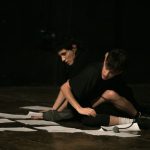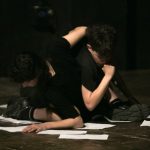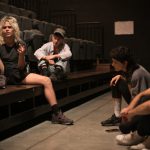Partner: Short Theatre
Play: Lettera aperta
Playwrights: Frani Dibiase and Roberto Leandro Pau
Translation session with: Simonetta Solder (from Austrian to Italian)
Meetings: 8-10 September 2025 at Teatro India, Rome
Public presentation: 10th September at 4pm at Teatro India, Rome, within the framework of the Short Theatre Festival
Tutor: Luciano Ariel Lanza
Cast: Frani Dibiase, Roberto Leandro Pau
photo by Claudia Pajewski
From 8 to 10 September 2025, in the frame of the Short Theatre Festival, AREA06 will organize an R&D workshop focused on LETTERA APERTA by Frani Dibiase and Roberto Leandro Pau, during which all dramaturgical possibilities of the text will be tested – both in its linguistic creation and in its somatic practices and movement dramaturgies. The text has been written over recent months, in parallel with Frani Dibiase and Roberto Leandro Pau’s participation in Eva Geatti’s workshops, in a continuum of contamination and inspiration. On 10 September at 4 pm at Teatro India, the workshop will open to a public session, sharing the work developed up to that point and launching all the potential and performative prefigurations of the text.
Lettera Aperta (Open Letter)
Lettera Aperta (Open Letter) is a performance that speaks of falling, joy and secrets. It stems from the need to train ourselves to encounter joy, to seek it out, defend it and nurture it. The pretexts for encountering it are letter writing and movement.
Lettera Aperta explores the form of the letter. Questions arise: what do I want to say? To whom? What do I want to say to this entity – living, dead, imagined – right now? I write a message that must travel through space and time before it arrives, if it ever does. It anticipates the possibility of a reply, which may not materialise. In this there is a leap into the void, a space that causes vertigo.
Lettera Aperta inhabits a middle ground where the focus is not on synthesis, but on experience. A place where joy and fall touch each other, where the secret is energy.
Frani Dibiase (1993) is an author and dancer. Her work focuses on translating signals expressed through movement, text and voice. Starting from herself in a feminist sense, her research is aimed at creating a subtle listening that opens up the possibility of slipping together into a shared energetic dimension. In alliance with Ida Malfatti, she creates the performances Elettrica and CCC. She is currently working on her latest creation, Animala prototipa, which is open in study form at BASE (MI). Since 2022, she has been part of the dormi|veglia group together with Zoe Francia Lamattina, Ida Malfatti and Chiara Cecconello. She is a dancer in Pastorale by Daniele Ninarello and his assistant. She is a performer in FRAGOLESANGUE by Monica Francia, Ida Malfatti and Zoe Francia Lamattina.
Roberto Leandro Pau (2001), performer. Through movement, he questions the mystery of presence in its generative peculiarity. He took part in the creation and staging of Eva Geatti’s La Vaga Grazia. He studies by participating in various seminars and workshops held by Cristina Kristal Rizzo, Claudia Castellucci and Giovanni Campo, among others. He is currently a performer in FRAGOLESANGUE by Monica Francia, Ida Malfatti and Zoe Francia Lamattina.
The piece suggests a structure that is at once metaphorical and highly physical, with a double-headed figure whose voices overlap, collide, and compete. This layered vocality – one voice growing stronger while the other fades into an echo – opens up exciting possibilities for staging, whether with live performers, recorded sound, or even spatialised audio.
The work could be read as a choreographic composition as much as a dramatic one. The image of limbs entangled, of roundness and verticality shifting and breathing, evokes a creature in constant transformation. I love the dramaturgical tension between head and tail: the head fixed in one place, the tail sliding away, leaving behind scattered pages, fragments of a torn letter. These elements give directors and performers the chance to play with materiality on stage – paper as a sign of memory, rupture, or reconstruction.
What interests me most is the exploration of “Lettera Aperta” as both text and gesture. Who is the addressee? Is it the audience, a specific other, or a void to be filled? The reflection on how long it takes a letter to arrive, how many hands it passes through, beautifully resonates with the idea of theatre as transmission – unstable, delayed, refracted. Here, words are not only language but rhythm, punctuation as a metronome, each phrase leading to a movement, a pause, or a shift in mood.
The creature at the centre of the piece is never static: it blocks, collides, opens, contracts, repeats. I find particularly compelling the suggestion to “exasperate the block” – repetition and insistence could become dramaturgical tools to map the creature’s journey. This potential to fragment and recompose, to scorporare and reassemble body, voice, and word, is the play’s greatest strength. It allows for a multiplicity of formal solutions – choreographic, musical, or visual – and makes the piece adaptable to different performance contexts.
Ultimately, what emerges is a fascinating hybrid form: a dramaturgy where the body writes, the voice draws, and the letter seeks a home. The creature is not just an image, but a process – one of becoming, dissolving, and reforming. This openness makes the work fertile ground for directors and performers, and I am convinced it could find powerful resonance on international stages.
– Simonetta Solder












